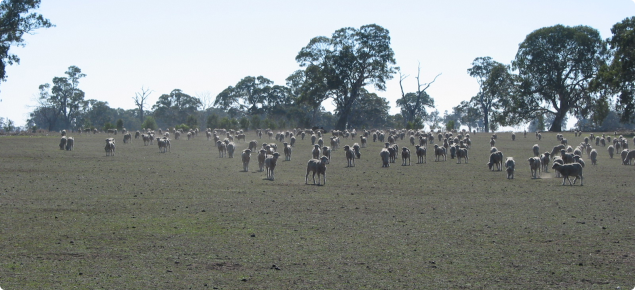In the event of an emergency, it is advisable to act as soon as possible to minimise the risk to lives and property and to ensure ample time to respond. A previously prepared emergency plan will help to guide response activities.
Animals respond differently to emergency situations, and may become frightened and stressed.
Animals should only be left behind when it is impossible to move them in advance or to take them with you. If you are still able to evacuate your animals please see our page on evacuating animals in emergencies.
With livestock and large animals, evacuation may not be possible without risking the safety or wellbeing of owners or carers and emergency responders. In some circumstances evacuation may not be possible if an emergency has occurred while owners or carers are away from their property and it is no longer safe to return. Where animals can't be evaucated, early precautionary preparations or relocation to safer areas within the property may improve an animal's wellbeing and chances of survival duing an emergency.
Precautionary preparation
A pre-prepared emergency plan will help you identify what risks you are likely to face and what preparations you need to take for your animals. In times of high risk, consider preparing your property in the event you need to leave suddenly, or if you may be away and unable to return.
- Fill water troughs and put out sufficient feed. Remember that you may not be able to return to your property for several days, so at least five days of water and food should be left.
- In case of fire, do not leave synthetic equipment, including rugs, on animals. These can melt and cause serious burns. Radiant heat can also cause metal buckles to become hot and cause burns to animals.
- In case of flood, move emergency feed and supplies to higher ground.
- In case of storm, check shelters and loose objects are secured to prevent injury.
- Tell a friend or relative where you can be contacted, where your animals are and what their needs may be.
- Leave a note for the emergency responders indicating what animals they will encounter in the home, and where and how you can be contacted.
Visit the Department of Fire and Emergency Services (DFES) for more information on preparing properties for natural hazards.
Safer areas: Relocation of animals on property
If an emergency alert is current or on days of high risk, consider moving animals into a safer area before leaving your property for any length of time.
Be aware of emergency information such as Emergency WA and ABC radio.
Horses
- Horses get easily agitated in extreme weather situations, particularly fire. If you are attempting to move horses when a fire is close, it may help to move paddock leaders/dominate horses first or blindfold them.
- Avoid shutting horses in stables or small yards unless the area is well protected from the hazard (fire, flood, etc).
- It is possible horses may receive only minimal burns if given plenty of room to move. They are known to gallop through flames or around the edges, and stand on the blackened, previously burnt area and remain there until the fire has passed. Open internal gates within the property– however do not compromise any boundary or external fencing, as this can pose a risk to people or emergency responders
Livestock
Stock may be reluctant to move once conditions get very hot, so they should be moved early in the day.
- During risk of fire, move stock to a location that is easy to access and has low fire fuel load; either cultivated paddocks with no vegetation, bared-out paddocks (minimal vegetation), green paddocks or near the homestead. Areas should be protected by firebreaks and free of leaf, twig and bark build-up.
- Avoid leaving them next to areas of scrub or bushland or, if unavoidable, at least large enough in size to allow animals to move well away from these areas.
- Ensure their location has sufficient drinking water to enable stock to remain in this area during periods of high to extreme temperatures for several days.
- If unsure where the safest place to leave stock is, open gates within the property to allow them to move between paddocks – however do not compromise any boundary or external fencing as this could lead to stock fleeing onto the road. This can pose a risk to people and emergency responders.
- In a flood, move animals to high ground with adequate natural feed (additional feed may be required for stock stranded for extended periods).
- In a severe storm, hail or a cyclone, place animals under solid cover if possible (eg sturdy barn/shed or covered pen)
- Mark gates and water locations on a map of your property and have this map available in an easy-to-find place in case someone has to move stock for you.
- For confined livestock (pigs, poultry), prepare the shelter for the hazard (eg roof sprinklers, secure loose fittings, sand bags).
Companion animals
- Where possible, leave your companion animals indoors:
- bring companion animals in early as they may instinctively run and hide in stressful and dangerous conditions
- if possible place companion animals (separated) in rooms with minimal furniture or where they are least likely to cause themselves any harm
- in the case of flood, position a heavy chair or crate to allow access to higher refuge such as benches, vanity units or shelves where adequate food and water should be left
- ensure chemicals, sharp objects and other hazards are locked away securely out of reach
- provide adequate food and water in large heavy bowls that can’t be tipped over (a slow-dripping tap can supply a constant source of water). Don't rely on automated/mains supplied sources
- provide toilet litter where appropriate and separate bedding.
- If companion animals have to be left outside do not tie them up.
- Poultry may be housed in a temporary pen in a lower risk area.
- Prepare avairies and shelters for the hazard (eg roof sprinklers, secure loose fittings, sand bags).
- Make sure all companion animals can be properly identified.
Read further on Evacuating animals in emergencies and Recovering for animal welfare after emergencies.


